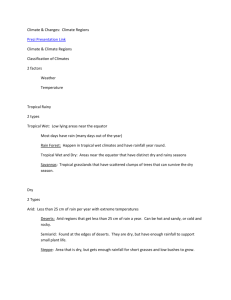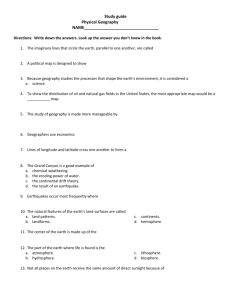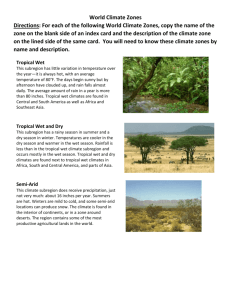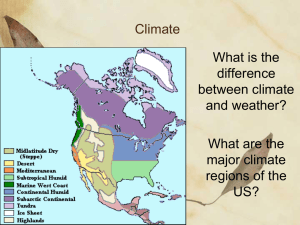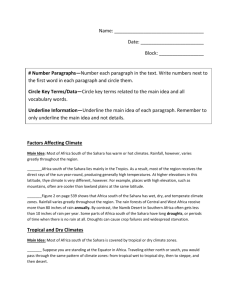Reading # 1
advertisement
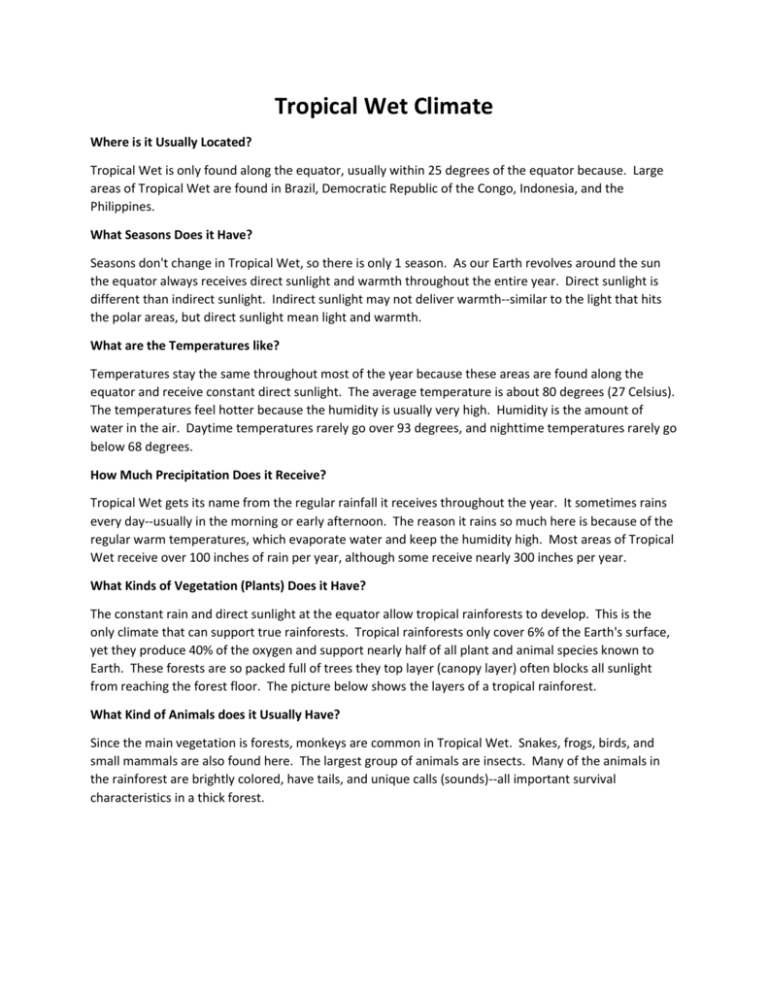
Tropical Wet Climate Where is it Usually Located? Tropical Wet is only found along the equator, usually within 25 degrees of the equator because. Large areas of Tropical Wet are found in Brazil, Democratic Republic of the Congo, Indonesia, and the Philippines. What Seasons Does it Have? Seasons don't change in Tropical Wet, so there is only 1 season. As our Earth revolves around the sun the equator always receives direct sunlight and warmth throughout the entire year. Direct sunlight is different than indirect sunlight. Indirect sunlight may not deliver warmth--similar to the light that hits the polar areas, but direct sunlight mean light and warmth. What are the Temperatures like? Temperatures stay the same throughout most of the year because these areas are found along the equator and receive constant direct sunlight. The average temperature is about 80 degrees (27 Celsius). The temperatures feel hotter because the humidity is usually very high. Humidity is the amount of water in the air. Daytime temperatures rarely go over 93 degrees, and nighttime temperatures rarely go below 68 degrees. How Much Precipitation Does it Receive? Tropical Wet gets its name from the regular rainfall it receives throughout the year. It sometimes rains every day--usually in the morning or early afternoon. The reason it rains so much here is because of the regular warm temperatures, which evaporate water and keep the humidity high. Most areas of Tropical Wet receive over 100 inches of rain per year, although some receive nearly 300 inches per year. What Kinds of Vegetation (Plants) Does it Have? The constant rain and direct sunlight at the equator allow tropical rainforests to develop. This is the only climate that can support true rainforests. Tropical rainforests only cover 6% of the Earth's surface, yet they produce 40% of the oxygen and support nearly half of all plant and animal species known to Earth. These forests are so packed full of trees they top layer (canopy layer) often blocks all sunlight from reaching the forest floor. The picture below shows the layers of a tropical rainforest. What Kind of Animals does it Usually Have? Since the main vegetation is forests, monkeys are common in Tropical Wet. Snakes, frogs, birds, and small mammals are also found here. The largest group of animals are insects. Many of the animals in the rainforest are brightly colored, have tails, and unique calls (sounds)--all important survival characteristics in a thick forest. Tropical Wet and Dry Climate Where is it Usually Located? Tropical Wet/Dry is found near the equator, usually on the outer edges of Tropical Wet climate areas. The largest areas of Tropical Wet/Dry are found in Africa, Brazil, and India. What Seasons Does it Have? There are only 2 seasons: wet season (summer) and dry season (winter). Usually the dry season is longer. During the dry seasons plant life and animal life suffers, but as the rainy season begins life flourishes in this area. This climate is caused by changing wind and ocean currents. What are the Temperatures like? During the wet season, temperatures average about 77 degrees. During the dry season, temperatures average about 68 degrees. The temperatures stay high throughout the year because of the latitude where this climate occurs. Areas near the equator receive constant direct sunlight and therefore, heat. The slight difference in temperature is enough to change the wind patterns and keep this area dry for much of the year, until the winds shift and the rainy season begins. How Much Precipitation Does it Receive? The change in precipitation is what gives this climate type is name. Precipitation only falls during the summer months, usually from May-August with June and July having the heaviest rain. The whole dry season usually has less than 4 inches of rain. During the wet season, at least 25 inches will fall. Some areas of Tropical Wet and Dry in the path of monsoon winds can receive incredible amounts of rain. Cherepunji, India once received over 1,000 inches of rain in a year! Northern Madagascar has the record for rain in one day--71 inches! Mawsynram, India is known as the "wettest place on earth" because they average 467 inches of rain per year. These incredible rainfall records are due to seasonal winds called monsoon, which bring dangerous amounts of rain. What Kinds of Vegetation (Plants) does it have? The lack of regular rainfall prevents most trees from surviving in Tropical Wet and Dry. So, the most common vegetation are type’s grasses and shrubs with a few scattered trees. These types of plants have adapted to long periods of dry weather. The large grasslands are often called savannas. What Kind of Animals does it Usually Have? The grasslands of Tropical Wet and Dry support many herbivores (plant eaters) who graze in the grasses. Most of these animals usually migrate and run in large herds for safety. Examples include wildebeests, gazelles, zebras, elephants, giraffes, etc. Many carnivores (meat eaters) follow and hunt the herbivores. Lions, cheetahs, hyenas, and large birds hunt the savannas of Africa. Mediterranean Climate Where is it Usually Located? Mediterranean climate is found between the 30o and 45o degree latitudes. This climate is often found on the western sides of continents. Mediterranean climate gets its name from the climate found around the Mediterranean Sea. What Seasons Does it Have? Mediterranean climate is very mild (few extreme temperatures), so it really on has 2 seasons: summer and winter. Summers are longer than winter, and the winter is very mild. Very few places experience snow in a Mediterranean climate. The seasonal changes are due to changes in ocean currents and water temperature. What are the Temperatures like? The climate is known for warm to hot, dry summers and mild to cool, wet winters. Winter temperatures are usually between 30 and 65 degrees. Summer months all average above 50 degrees. The warmest month averages about 72 degrees. The cause of this climate is directly related to large bodies of water such as the Mediterranean Sea and ocean currents. During the summer, cold currents keep the climate mild and dry. Ocean currents shift as the seasons change. During the winter the water that was warmed up all summer moves in and keeps the land warm and often brings rain. How Much Precipitation Does it Receive? Mediterranean climate is a fairly dry climate. Almost no rain falls during the summer, so most of the rain falls during the cooler winter. The summer experiences cold ocean currents that bring dry air and no precipitation. During the winter the currents shift and warmer, moist air brings rain to these areas. Snow can fall in higher elevation areas or places that are farther north. Mediterranean climates receive around 20 inches of annual (yearly) rainfall. What Kinds of Vegetation (Plants) Does it Have? Plants in Mediterranean climate must be able to survive long dry summers. Evergreeens such as Pine and Cypress trees are mixed with deciduous tress such as some Oaks. Fruit trees and vines such as grapes, figs, olives, and citrus fruits grow well here. Other plants include what are called "scrub", which include small shrubs, grasses, and herbs. What Kind of Animals Does it Usually Have? In order to survive here, animals must be able to live in rugged land and not depend too much on large areas of grass to graze. The natural wildlife found here include goats and sheep. These animal graze, but eat a wide variety of plants compared to cows who rely on grasses. Rabbits, jackels, and lynx can also be found here. Humid Subtropical Climate Where is it Usually Located? The Humid Subtropical climate is found on the east coast of continents between 20 and 40 north and south of the equator. The southeast United States is a good example of this climate. Florida has a Humid Subtropical climate. What Seasons Does it Have? Temperatures usually stay high (above 70) throughout the year, but cool down for a few months, so there are really only 2 seasons here: summer and winter. However, the winter season is not a cold winter. Summer season lasts longer, since Humid Subtropical areas are somewhat near the equator. What are the Temperatures like? Humid Subtropical climate is known for hot humid summers and mild winters. During the summer the average temperature is between 70 and 80 degrees. The coldest month usually averages 45-50 degrees. Since Humid Subtropical is found between 20o and 40o latitude, they receive direct sunlight for a large part of the year. How Much Precipitation Does it Receive? Most Humid Subtropical areas receive about 48 inches of rain each year. The rain falls throughout the year. The regularly high temperatures evaporate water, which causes humidity and precipitation. The high humidity in this region makes summer temperatures feel even hotter. Humid Subtropical areas usually experience strong storms such as tornadoes and hurricanes. What Kinds of Vegetation (Plants) Does it Have? The natural vegetation found in Humid Subtropical areas are mainly evergreen trees, bushes, and shrubs. These are not the hardy evergreen trees like pine and spruce. Most of these evergreens are more delicate. The reason many plants here are evergreens is because of the long months of warmth and regular rain. These plants have adapted to the regular climate conditions. Many broad-leaf evergreens such as palm trees and ferns are found here. Many plants can be farmed here since the growing season is sometimes 8 months long. What Kind of Animals Does it Usually Have? Humid Subtropical supports many types of mammals, reptiles, and amphibians. Alligators, deer, and panthers can be found in the US. Brazil's subtropical area has the capybara, which is the worlds largest rodent.
